Just like rice dishes that form a major part of regional Indian cuisine, there are many breads too, that are just as important in different regions pan India. One such unique preparation of a South Indian style bread is the Dibba Rotti. Also, known as Minapa Rotti, it is a popular breakfast snack made in many households across Andhra Pradesh. The ingredient list is not much but there’s a certain way that this bread gets made. This vegan recipe is going to help you do just that.
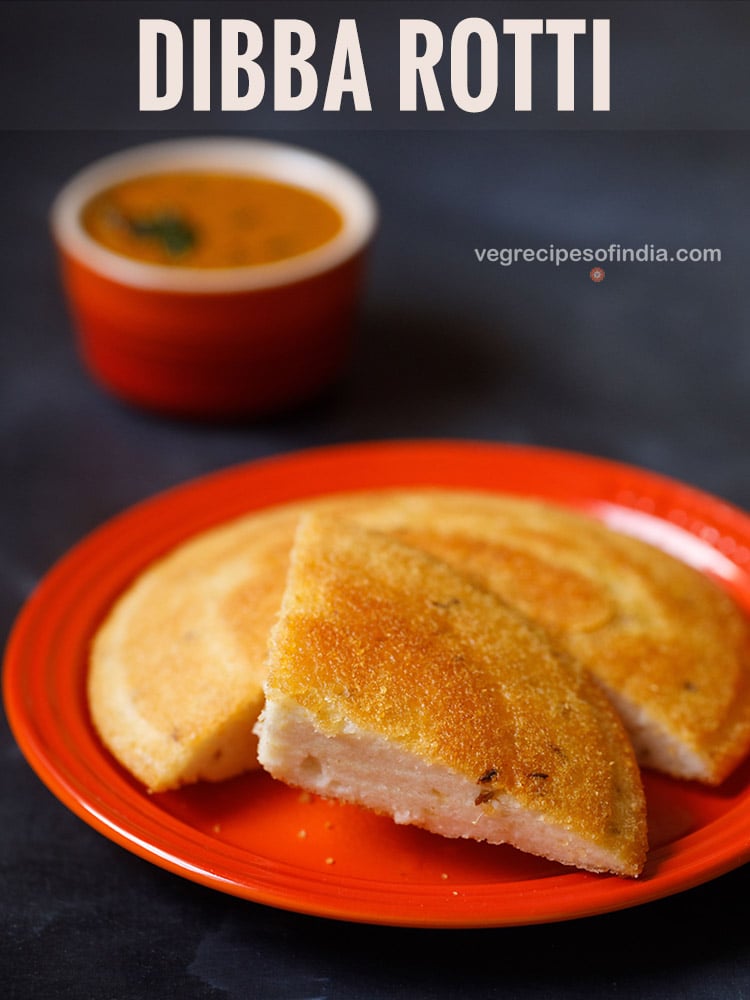
Table of Contents
What is Dibba Rotti
In Telugu language, the word ‘dibba’ means ‘plump,’ ‘fat’ or ‘stout’ and ‘rotti’ is simply a ‘bread.’ Thus, in literal term, Dibba Rotti means a bread which is plump, fat or stout. Although it means a thick bread but the texture and taste is nowhere like a regular bread.
Dibba Rotti is more like a crisp, thick and spiced idli which we all like at home. You can even say that it is a combination of a soft idli and a crispy dosa.
Though, this is essentially a breakfast dish in Andhra Pradesh, it can be served in brunch or as an evening snack too. At my home, the combination of Minapa Rotti and coconut chutney, ginger chutney or Avakaya Pickle is a favorite.
Dibba Rotti is primarily made from husked, split black gram or urad dal and rice. The rice is in a rava form, which is rice ground to fine granules.
The procedure begins by grinding the urad dal into a batter first, and then mixing the soaked rice rava in it. Some spices and herbs are also added to this mixture.
It is best to use a heavy, shallow kadai to cook the Dibba Rotti, although, a shallow frying pan can also be used. The kadai is smeared with oil and then the batter is spread into a neat round.
This is then slow-cooked to a perfect crisp golden exterior. Later, to be served with a chutney of your choice. Like, onion chutney, ginger chutney or coconut chutney.
Taste & Texture of Dibba Rotti
Since the Dibba Rotti is slow-cooked on low heat, this makes the exterior nice and crispy and golden. However, the inside texture is soft and similar to the texture of an idli. This is then cut into wedges and served. So, you get to taste the crusty exterior along with the soft and fluffy inside.
The flavor of Dibba Rotti is not like that of Idli, as there is no sourness in the batter (as the batter is not fermented). However, the taste is similar to that of a rava idli made without spices. The crispy texture also adds to the taste.
Overall, the texture and taste of Dibba Rotti is so good that you will keep asking for more. For the rice rava, you can use fine rice rava or even idli rava. I usually make this Minapa Rotti with idli rava, as I always have it in my kitchen.
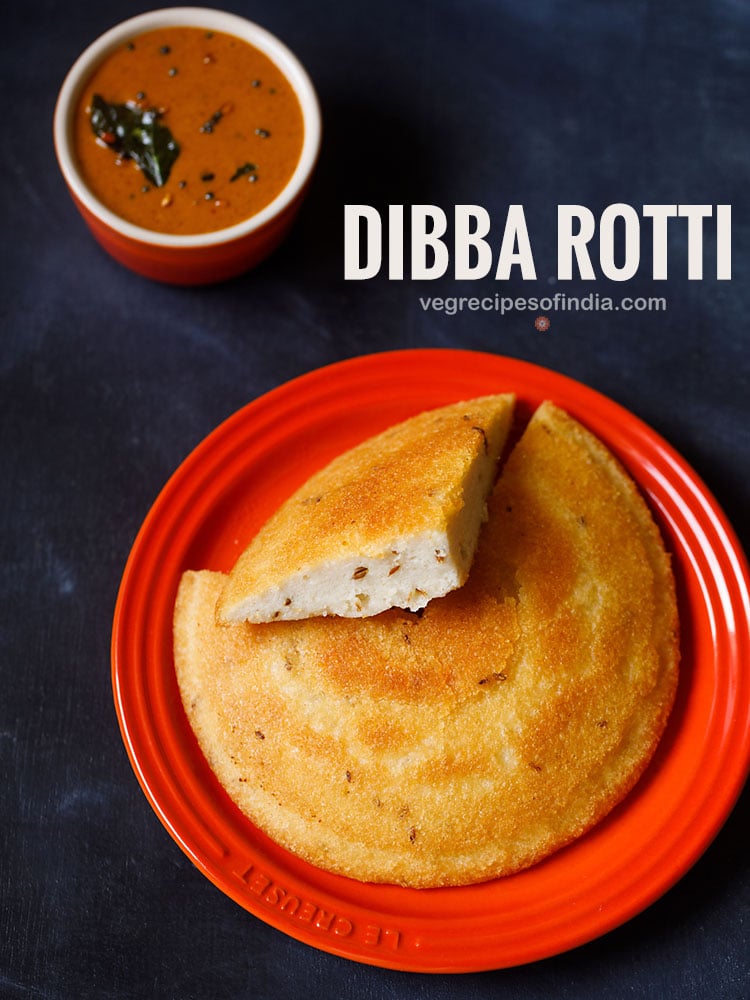
More on Dibba Rotti Recipe
Here are some of the pointers that prove that this recipe of Dibba Rotti is a rockstar:
- Traditionally, for making this rotti, no fermentation is required in its batter. However, if you want, you can keep the batter for 2 to 3 hours after grinding.
- You just need to soak urad dal and rice rava. Then, grind only the urad dal to make a soft fluffy batter. Mix soaked rice rava in this batter and proceed in making the Minapa Rotti.
- The most important spice that you must not forget to add in this recipe of Dibba Rotti is cumin seeds (jeera), as it helps in digestion. Apart from this, you can make variations by adding spices and herbs like green chilies, ginger, curry leaves, asafoetida (hing), coriander leaves, crushed black pepper and onions.
- With the same method, you can even use your regular Idli Batter to make this Minapa Rotti.
How to make Dibba Rotti
Soak Urad dal and Rice Rava
1. Rinse ½ cup (125 grams) urad dal a couple of times in water. Drain all the water and then soak urad dal in 1 cup water for 3 to 4 hours.
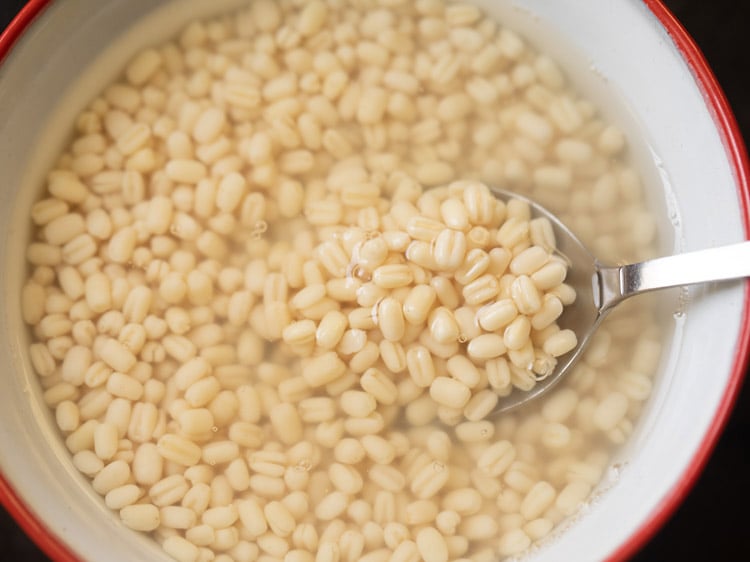
2. Take ¾ cup (155 grams) rice rava or idli rava in a large bowl. We will first rinse the rava. Add water till it floats a few centimetres on top of the rava layer.
Gently mix the rava with water. Let this mixture rest for some seconds. Gently, discard the water from the top.
Do this method once or twice. Then, add 1.5 cups water for soaking rice rava for 3 to 4 hours.
Note: If you do not have rice rava, then soak ¾ cup rice in water for 3 to 4 hours. Drain all water. Spread rice on a plate or tray for about an hour. Then, grind to a semi-fine texture of that of rice rava or idli rava.
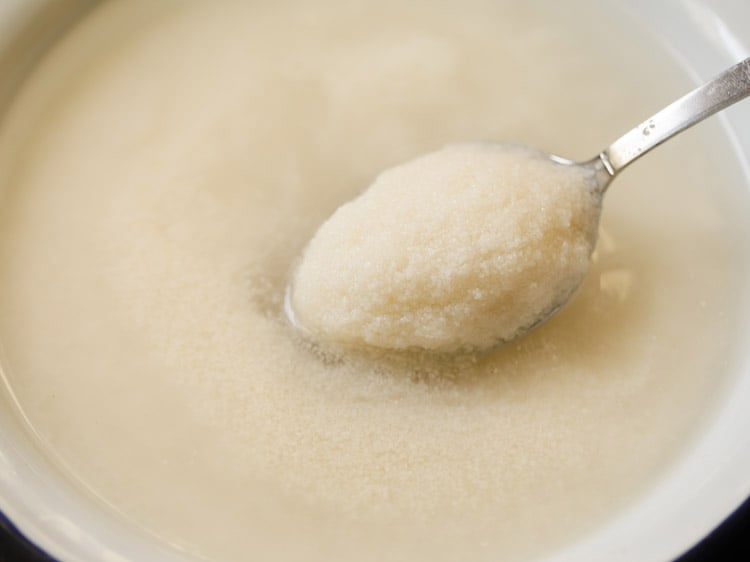
Grind Urad Dal
3. Later, drain all the water from urad dal and add in a grinder or a high speed blender.
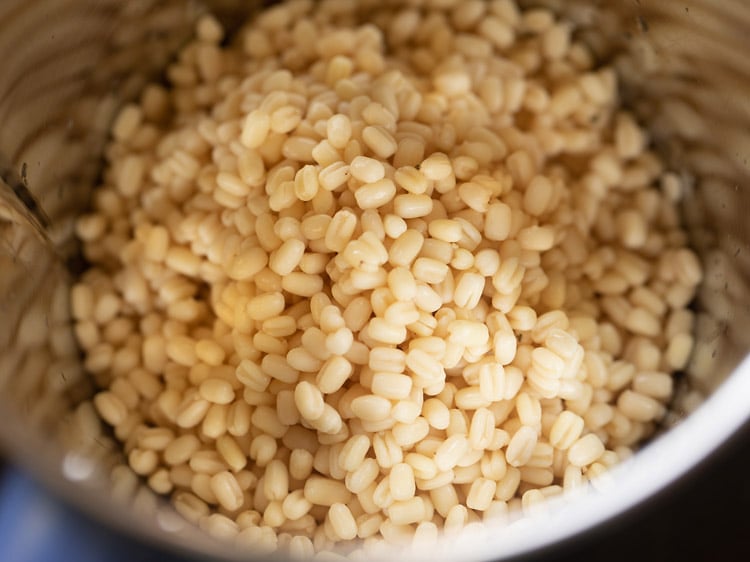
4. Add ½ teaspoon chopped ginger and 1 chopped green chilli (½ teaspoon).
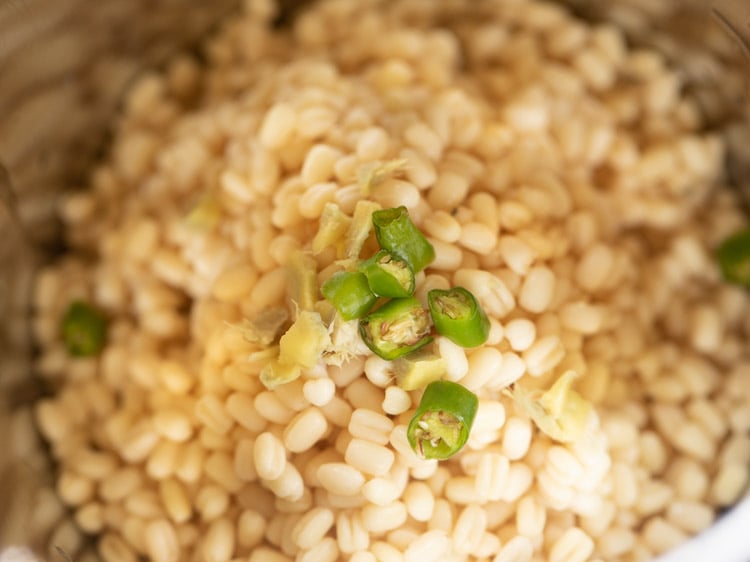
5. Add ½ cup water in parts and grind to a smooth fluffy batter. I added ½ cup water for grinding urad dal. But depending on the quality of urad dal, you will need less or more water.
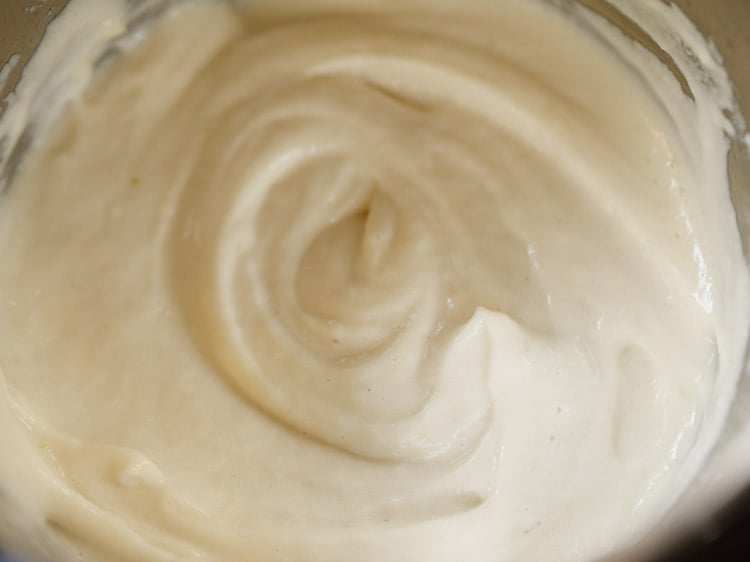
6. Take the urad dal batter in a large bowl or pan. Keep aside.
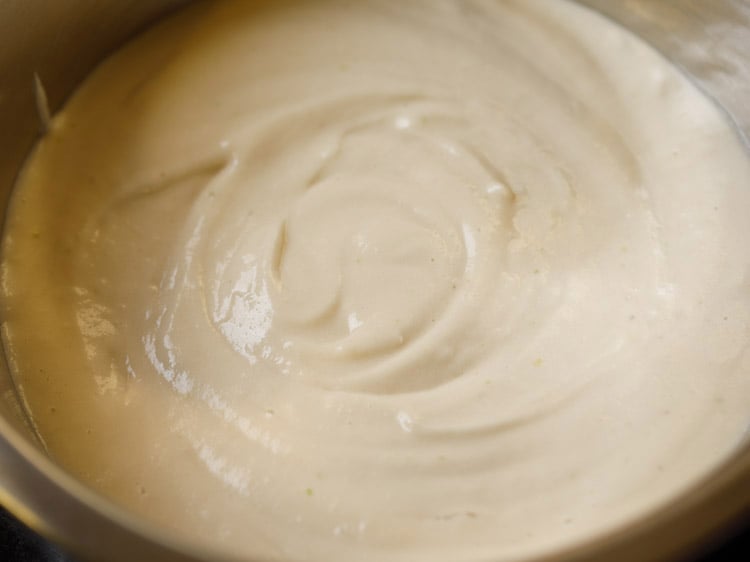
Make Dibba Rotti Batter
7. Take some portion of the rice rava mixture in your palms. Press tightly and squeeze all the water from the idli rava.
Let the water get squeezed in the same bowl. Make sure that you squeeze the rice rava or idli rava very well.
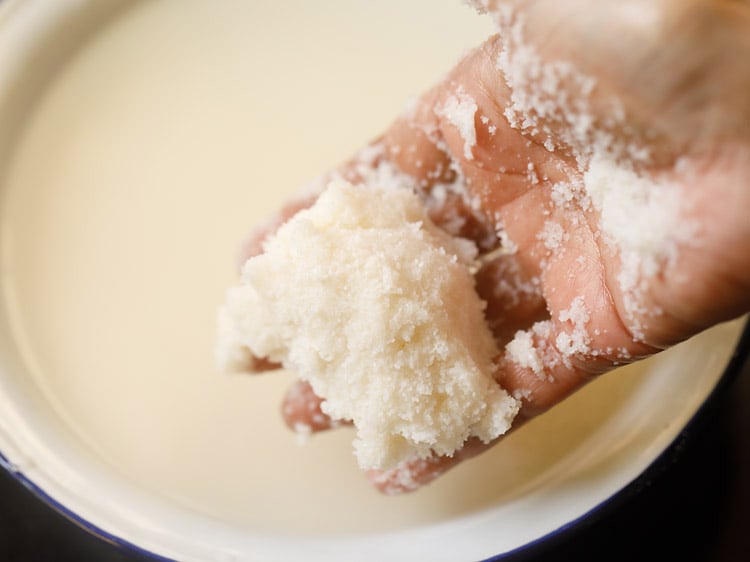
8. Add this squeezed portion of idli rava in the urad dal batter. Repeat the above step and this way add the entire squeezed idli rava to the urad dal batter.
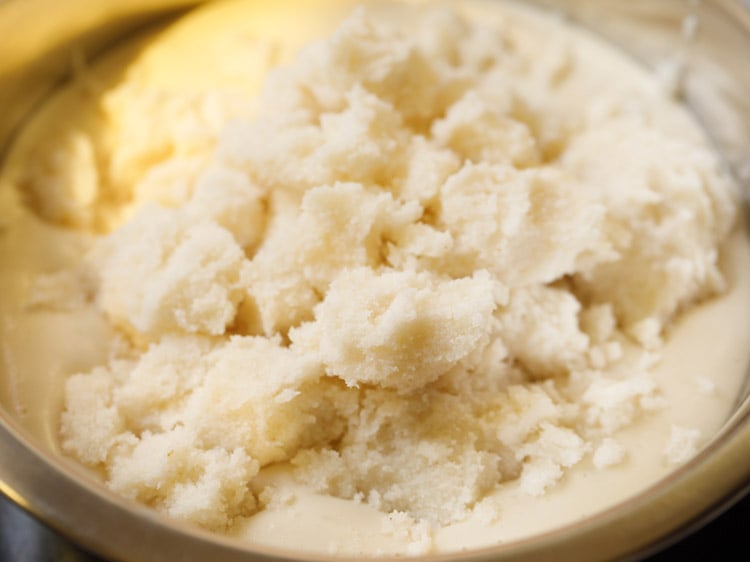
9. Add 1 teaspoon cumin seeds and ½ teaspoon salt or as required.
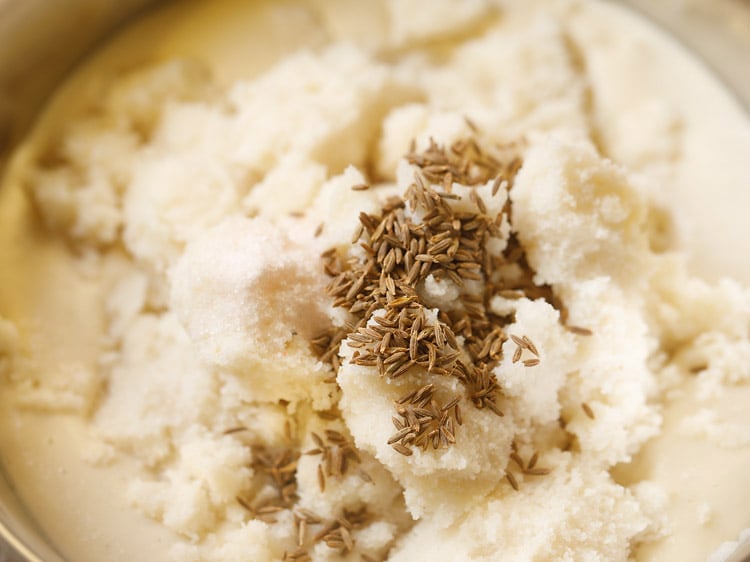
10. Mix very well.
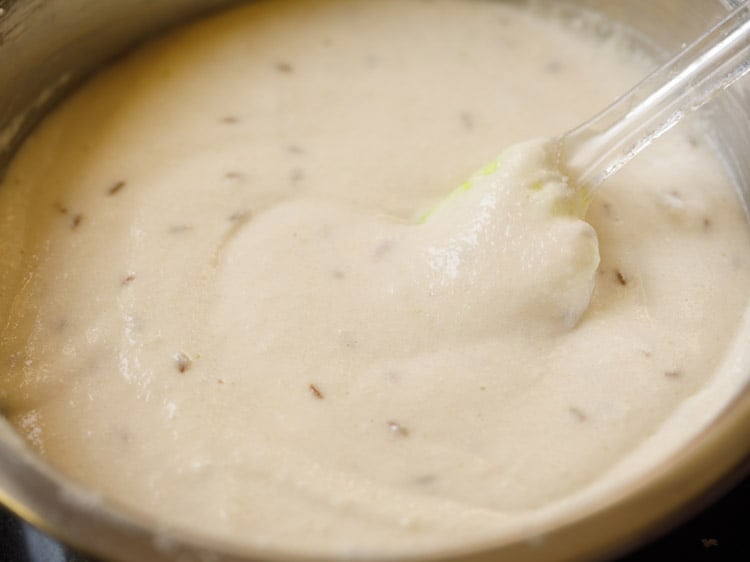
11. The batter consistency is like that of idli batter. In case the batter looks thin, then add some more rice rava which has been soaked in water and later squeezed of all the water.
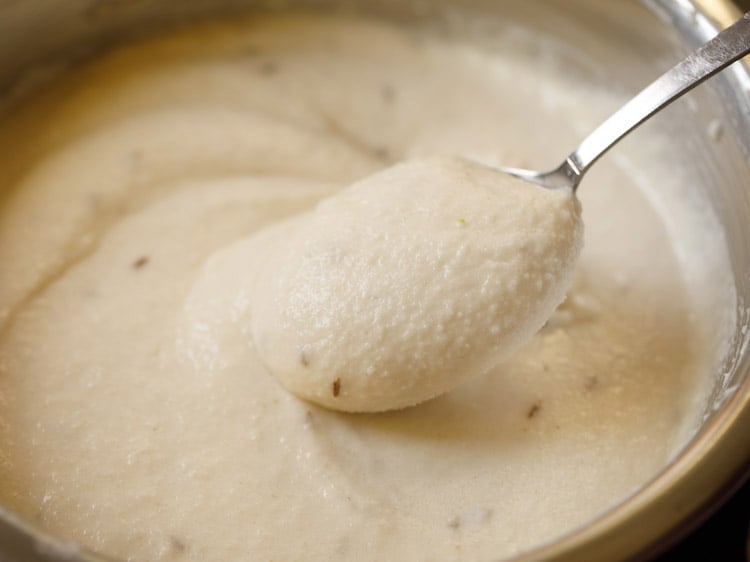
Make Dibba Rotti
12. Take a heavy and thick bottomed kadai or frying pan. Add 2 tablespoons peanut oil in the kadai. Then, spread the oil on the sides of kadai by tilting the kadai or with a spoon.
Let the oil become hot, but not sizzling hot. Do use a heavy iron kadai or a heavy pan with a solid base or else the rotti can get burnt. Peanut oil gives a good taste, but you can use any other neutral flavored oil.
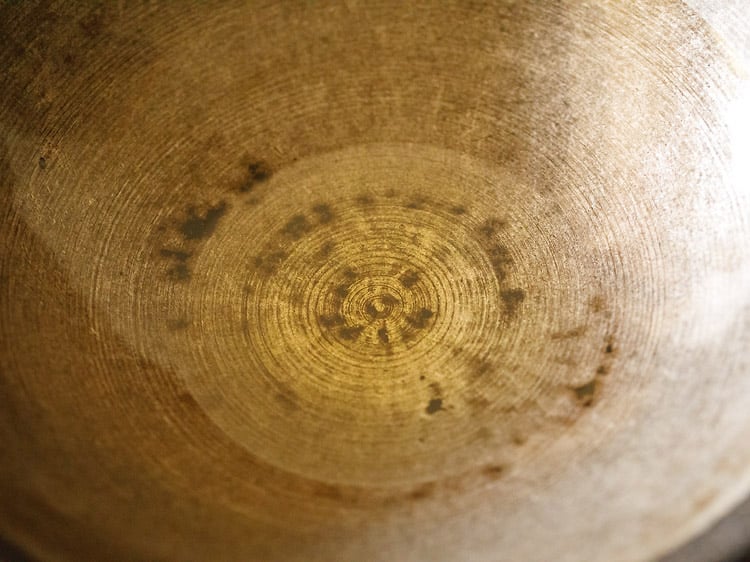
13. Once the oil becomes hot, reduce the heat to the lowest. Add 3 large ladles of the prepared batter.
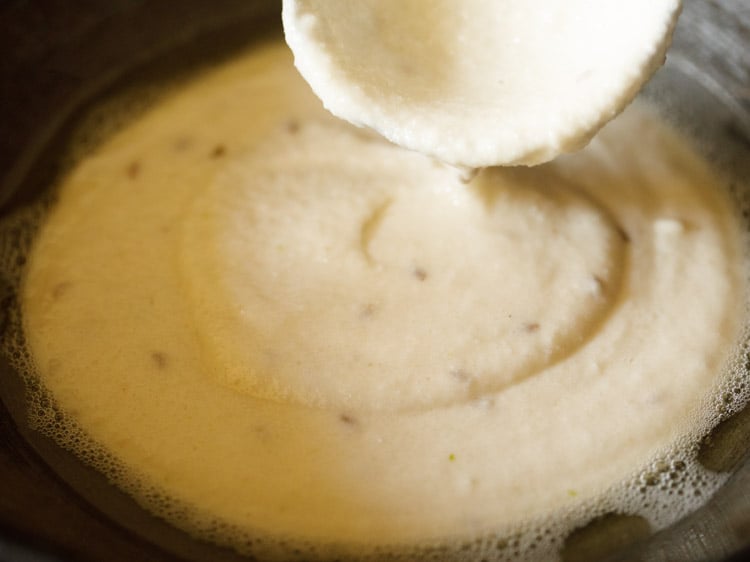
14. Gently spread and even out the batter from the top with the back of a spoon.
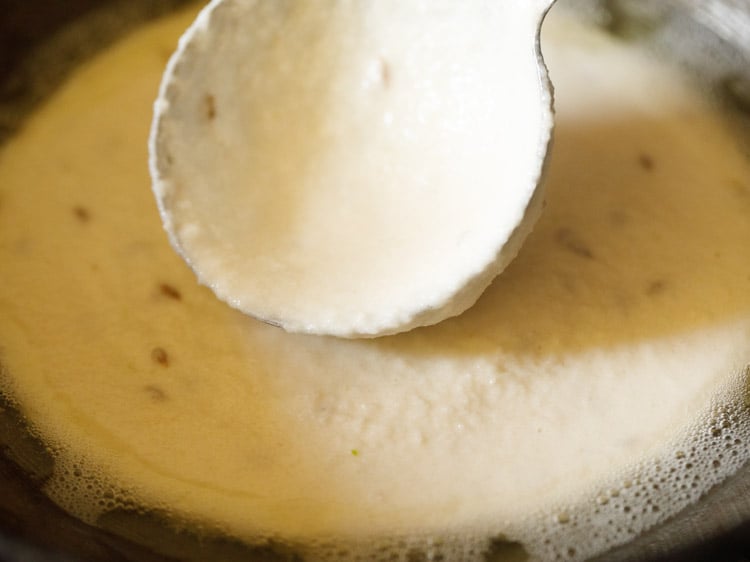
Cook Dibba Rotti
15. Cover the layer of Dibba Rotti and cook on low heat.
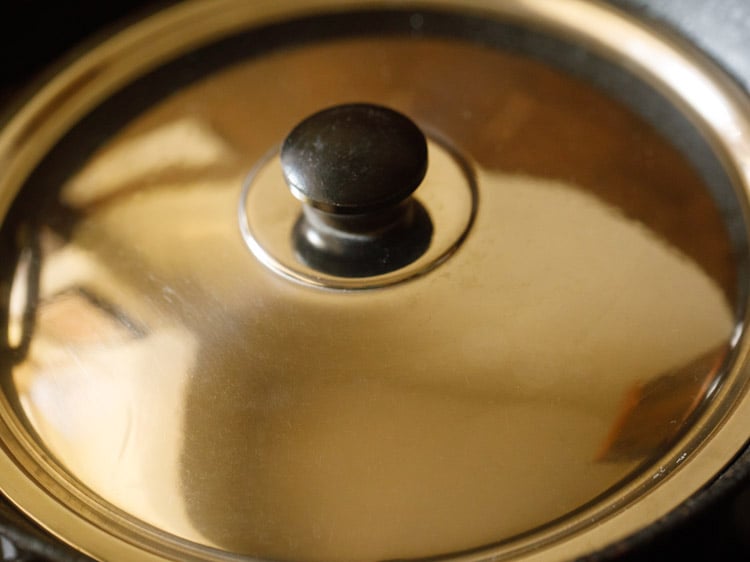
16. Cook till the base of the rotti is crisp and golden. You can make this out by checking the edges from top.
The edges will have a golden color. It takes approximately 20 to 25 minutes for the rotti to get cooked completely.
Though, timing will vary with the intensity of heat, size, thickness and heaviness of the kadai or pan.
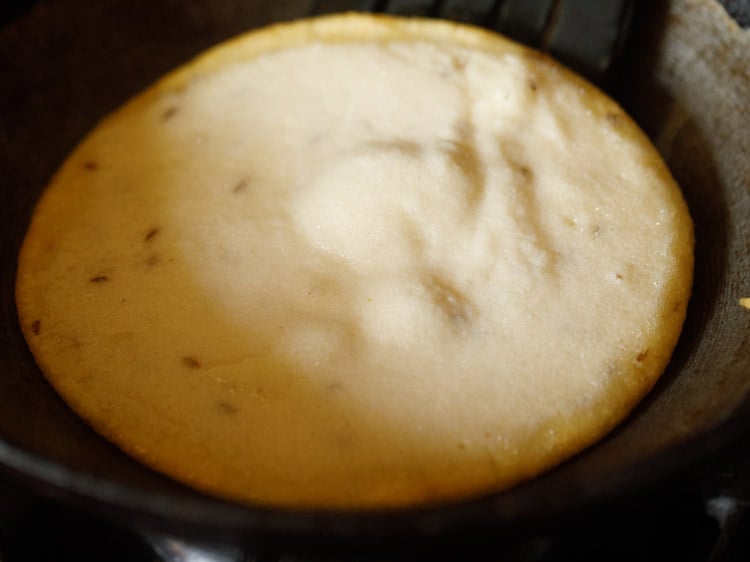
17. Then, turn over the half-cooked rotti gently with a spatula. In case the base has not become golden and crispy, then continue to cover and cook till it becomes golden.
Now, cook the second side. Drizzle 1 to 2 teaspoons peanut oil on the sides. While cooking the second side, do not cover and cook.
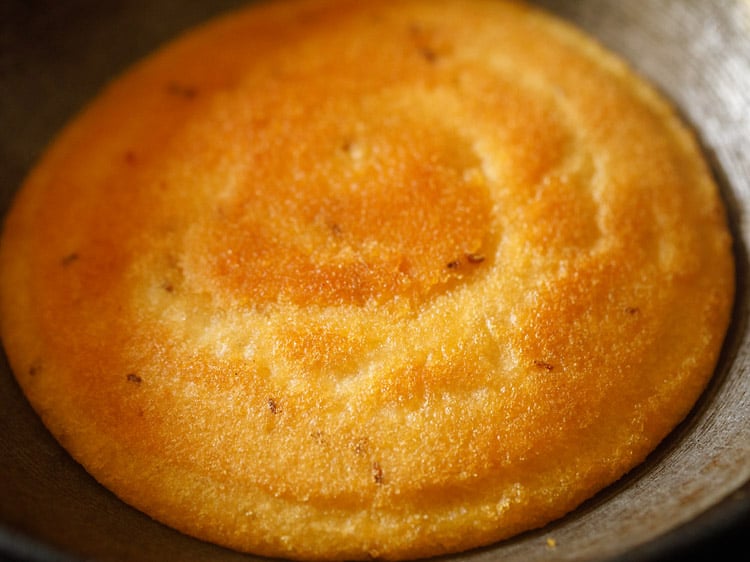
18. Cook till the second side is cooked properly and you see some golden spots. To check, you can insert a toothpick, fork or knife and these should not have any sticky or uncooked batter on them.
Similar way, make more Minapa Rottis from the remaining batter. Every time you make a rotti, add 1 to 2 tablespoons oil. If you see oil in the kadai or pan, then add 1 to 1.5 tablespoons oil.
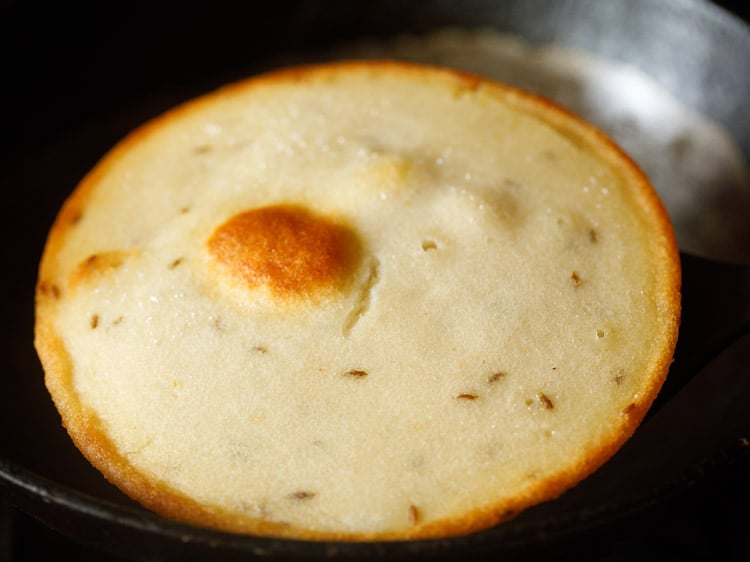
19. Remove rotti from pan and place on a chopping board. Slice in wedges or squares and serve Dibba Rotti with onion chutney, ginger chutney, tomato chutney or coconut chutney.
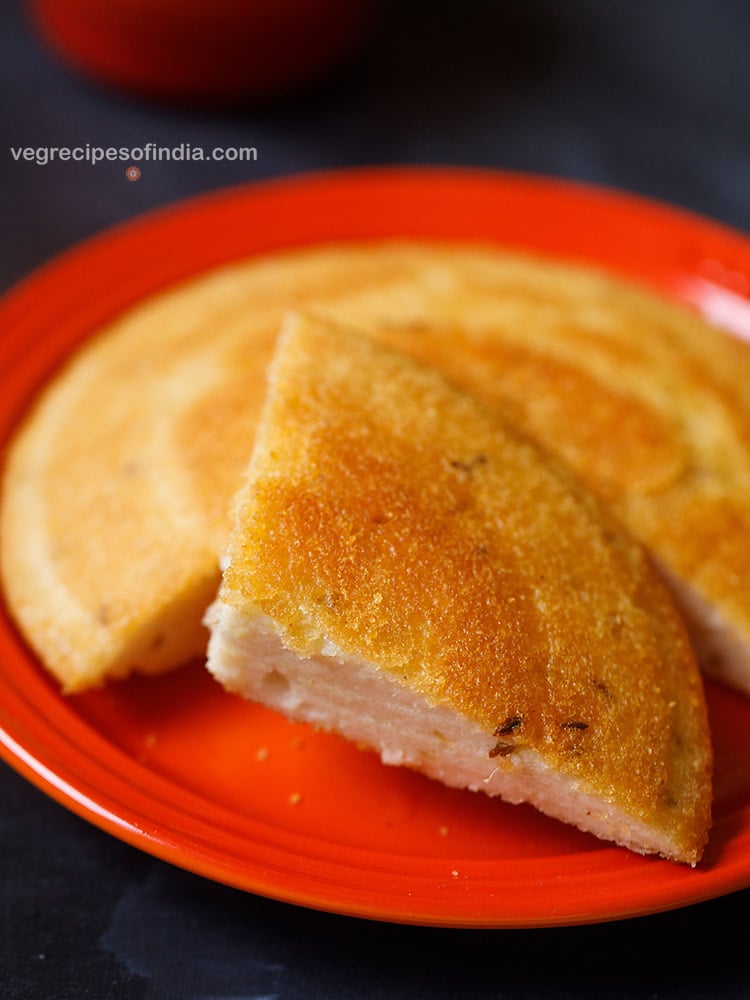
Expert Tips
- Traditionally, a Dibba Rotti batter is not fermented. Use directly or if you want, keep for 2 to 3 hours. Do not ferment.
- If you don’t have rice rava, then soak ¾ cup rice in water for 3 to 4 hours. Spread it on a plate or tray for about an hour. Then, grind to a semi-fine consistency and use.
- Depending on the quality of urad dal, you will have to add less or more water. This urad dal batter has to be smooth and fluffy.
- Make sure to make the final batter of thick consistency, like that of idli batter. If it is thin, then add some more rice rava that has been soaked in water and later squeezed of all the water.
- You can add curry leaves, crushed black pepper, asafoetida, onions and coriander leaves to the batter. Traditionally, it is made with cumin seeds only.
- If possible, use peanut oil for a good taste. If not available, then you can use any other neutral flavored oil.
- Make sure to use a heavy iron kadai or heavy pan with a solid base, or else the rotti can get burnt.
- The time to cook the Minapa Rotti will vary with the intensity of heat, size, thickness and heaviness of the kadai or pan.
More Roti Recipes To Try!
Indian Breads
Vegan Recipes
Indian Breads
Indian Breads
Please be sure to rate the recipe in the recipe card or leave a comment below if you have made it. For more vegetarian inspirations, Sign Up for my emails or follow me on Instagram, Youtube, Facebook, Pinterest or Twitter.
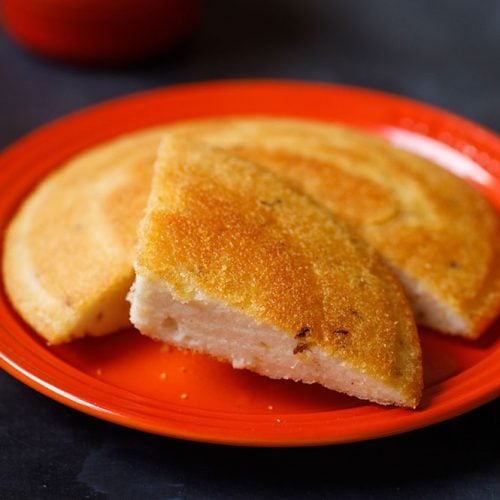
Dibba Rotti | Andhra Minapa Rotti
Ingredients
For making batter
- ½ cup urad dal – 125 grams (husked & split black gram)
- 1 cup water – for soaking urad dal
- ½ cup water – for grinding urad dal or add as required
- ¾ cup rice rava or idli rava – 155 grams
- 1.5 cups water – for soaking rice rava
- 1 green chilli or ½ teaspoon, chopped
- 1 teaspoon cumin seeds
- ½ teaspoon salt or add as required
For cooking
- 4 to 6 tablespoons peanut oil or add as required – can also use any neutral flavored oil
Instructions
Soaking lentils and rice rava
- Rinse urad dal a couple of times in water.
- Drain all the water and then soak urad dal in a bowl with 1 cup water for 3 to 4 hours.
- Take rice rava or idli rava in a large bowl. We will first rinse the rava.
- Add water till it floats a few centimetres on top of the rava layer. Gently mix the rava with water. Let this mixture rest for some seconds. Gently discard the water from the top. Do this method once or twice.
- Then add 1.5 cups water for soaking rice rava for 3 to 4 hours.
- Later drain all the water from urad dal and add in a grinder or a high speed blender.
- Add chopped ginger and chillies.
Making batter
- Add ½ cup water in parts and grind to a smooth and fluffy batter. Depending on the quality of urad dal, you can add less or more water to grind.
- Transfer the entire urad dal batter in a large bowl or pan. Keep aside.
- Take some portion of the rice rava mixture in your palms. Press tightly and squeeze all the water from the idli rava. Let the water get squeezed in the same bowl. Do make sure that you squeeze the rice rava or idli rava very well.
- Add this squeezed portion of idli rava in the urad dal batter. Repeat the above step and this way add the entire squeezed idli rava to the urad dal batter.
- Add cumin seeds and salt or add as required.
- Mix very well.
- The batter consistency is like that of idli batter. In case the batter looks thin, then add some more rice rava which has been soaked in water and later squeezed of all the water.
Making dibba rotti
- Take a heavy and thick bottomed kadai or frying pan. Add 2 tablespoons peanut oil in the kadai.
- Then spread the oil on the sides of kadai by tilting the kadai or with a spoon. Let the oil become hot, but not sizzling hot.
- Once the oil becomes hot, reduce the heat to its lowest. Add 3 large ladles of the dibba rotti batter.
- Gently spread and even out the batter from the top with the back of a spoon.
- Cover the layer of dibba rotti. Cook on a low heat.
- Cook till the base of the dibba rotti is crisp and golden. You can make this out by checking the edges from top. The edges will have a golden color.
- Then turn over the half-cooked dibba rotti gently with a spatula. In case the base has not become golden & crispy, then continue to cover and cook till it becomes golden.
- Now cook the second side. Drizzle 1 to 2 teaspoons peanut oil on the sides. While cooking the second side, do not cover and cook.
- Cook till the second side is cooked properly and you see some golden spots. To check you can insert a toothpick or a fork or knife and they should not have any sticky or uncooked batter on them.
- Similar way make dibba rotti from the remaining batter. Every time you make dibba rotti, add 1 to 2 tablespoons oil. If you see oil in the kadai or pan, then add 1 to 1.5 tablespoons oil.
- Remove from the pan. Place on a chopping board. Slice in wedges or squares and serve with onion chutney or ginger chutney or coconut chutney.
Notes
- You can add curry leaves, crushed black pepper, asafoetida, onions and coriander leaves to the batter. Traditionally made with cumin seeds only.
- Traditionally batter is not fermented. Use directly or keep for 2 to 3 hours. Do not ferment.
- If possible use peanut oil for good taste. But you can opt to use any other neutral flavored oil if you do not have peanut oil.
- Batter consistency is thick like idli batter.
- If you do not have rice rava, then soak ¾ cup rice in water for 3 to 4 hours. Drain all water. Spread rice on a plate or tray for about an hour. Then grind to a semi-fine texture of that of rice rava or idli rava.
- Do use a heavy iron kadai or a heavy pan with a solid base or else the dibba rotti can get burnt.
- The recipe can be scaled to make for less or more portions.
Nutrition Info (Approximate Values)
This Dibba Rotti recipe from the archives first published in March 2019 has been updated and republished on February 2023.
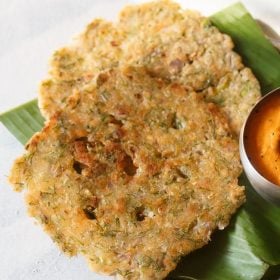
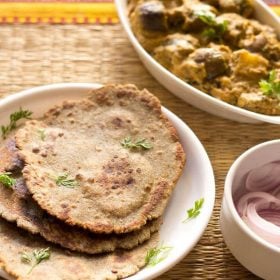
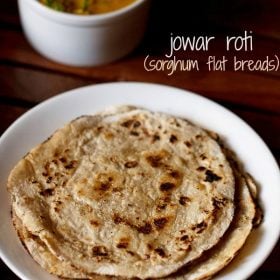
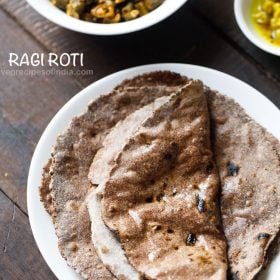
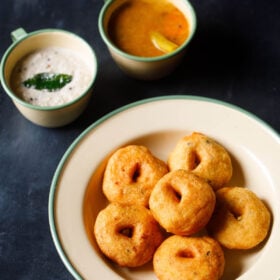
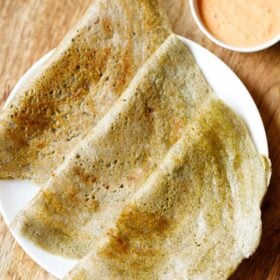
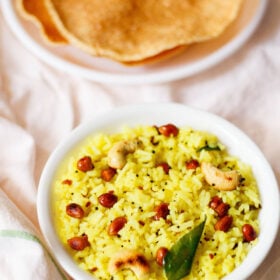
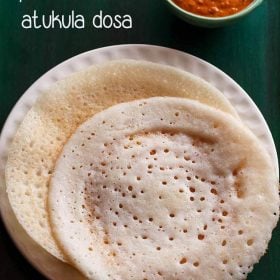








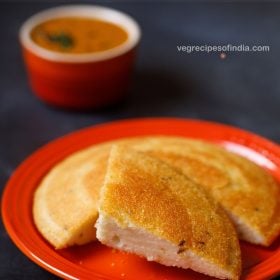
Hi Mrs Dassana. I’m a big fan of your recipes. I’m Suneeth Daniel from Nizamabad, Telangana. I never actually commented on your recipes, so this is my first time here.
You really are a foodie, I can say that from the way you describe your recipes in detail to us fans and foodies.
It’s not just your recipes but your crystal clear explanation of each recipe makes it mouth watering and longing for those dishes until we make those delicious recipes and savor them for ourselves all the while sitting at the comfort of our homes.
I am a boy from Telangana but my mom’s relatives are from Andhra Pradesh, so you may have understood by now that I must have tried Dibba Roti quite a few times and I can vouch for your delicious dibba rotti recipe that you have shared with us.
I hate eating outside. I love home food more than anyone in my family but unfortunately we don’t have any ladies in our home and it’s been very hard for us to eat healthy food for a very long time.
Thanks to you I can make delicious dishes for myself and for my father and brother from the comfort of my home without anyone’s help.
You always amaze me with your awesome recipes and it feels like there is no end to your quest for food. It’s literally mind-blowing to see you produce those recipes with such fine writing and the quality of the pictures and videos of the same.
You must be going to tremendous lengths to bring us foodies such regional recipes. So, I can say that you invest a lot of time and effort into your each and every recipe and therefore I’m a big fan of your recipes. Lots of respect to you Ma’am.
Please continue the amazing work you are doing right now and bring us more wonderful dishes in the future too. May the Lord, God give you good health, happiness and success to you and your family throughout your life. Thank you:)
Thanks so much Suneeth for this inspiring and encouraging feedback. Grateful and glad! I wish you all the best in your life. Thanks again.
I made according to your recipe show step by step it really comes out excellent my family members love it lots. I added some more masala which is my my choice. Thank you for your recipe . waiting for your more like this tasty recipes.
thanks samita for this feedback on dibba roti. more spices and herbs can be easily added as per one’s choice. i do plan to add some more recipes. welcome and happy cooking.
Dasanna, thanks for your response to my comment. After I posted my comment, I called my niece who lives in Rajahmundry (East Godavari District, AP) and she told me that the coarse rice rawa (or Ravva) for making dibba rotti is available in grocery stores there. I am not sure how popular is this rotti in Hyderabad but it is very popular in coastal Andhra Pradesh. Once again the tastes and the food choices of the current generations is drastically changing. So, most of the younger generations may not even bother to prepare this or even know about this item.
thank you rom for sharing this information. next time whenever i visit the coastal areas of AP, i will check for the ground rice. yes i agree that the food habits of younger generation is way different than ours. lack of time is another reason why food which has an extensive preparation and is time-consuming is not prepared.
Your recipes are very well described and easy to follow.Thank you.
thanks and welcome.
Your recipe brought back memories of eating this dish back in 1960s when my mother used to make this quite often. This is very delicious and filling. My mother used to add a handful of pre-soaked cow peas (red chori or bobbarlu as they are called in Telugu) to the batter. While frying the batter, the cow peas also will cook along with the batter. The cow peas will give a real nutty taste, while eating the rotti. Besides, they provide some protein content. A couple of finer points while making “dibba rotti” – The rawa used is a bit coarser compared to typical idli rawa, even though, using idli rawa won’t alter the dish that much. In Andhra many shops used to carry this type of coarse rice rawa for making dibba rotti. I left India 40 yrs ago and I am not sure if this rawa is still available there or not. May be they still do. The second point is – I prefer to fry this batter in sesame oil, although, peanut oil is another best choice. I hope all your followers will try this recipe and enjoy dibba rotti. Anyway, keep up the great blog and I sure do enjoy reading your recipes. Good Luck
thank you rom for sharing your memories. felt nice reading your comment. cowpeas is a good addition. regarding the rice rawa, not sure if the shops still sell them. we lived in hyderabad for some time but i never saw any shop selling this rice rawa. i need to cook dibba rotti in sesame oil. i am sure it will give a different taste. thanks again and happy cooking.